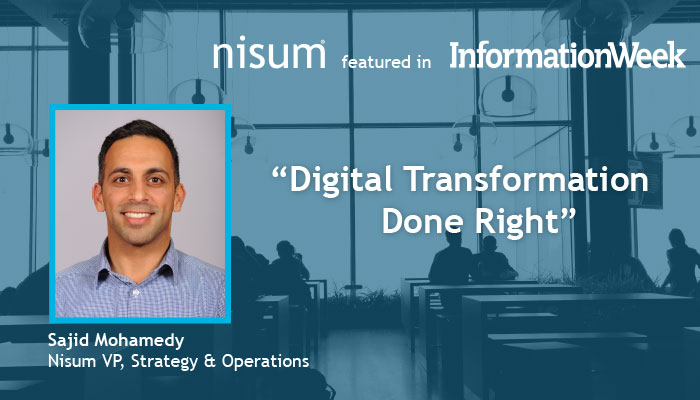Nisum Director, Shami Ahuja, discusses best practices of how to manage projects efficiently to keep them on budget and on schedule in her SD Times article. In "Six Tenets of Successful Project Management," she lists six elements that successful project managers (PMs) incorporate into their strategies, which touch upon communication, goals, processes, dependencies, engagement, and the importance of kick-off meetings. Read the full text below or on SDTimes here.

Six Tenets of Successful Project Management
For every network upgrade, hardware installation, cloud rollout or software update, there are countless tales of IT projects gone awry. As a result of poor project management, it’s all too common for projects to go over budget and past deadlines, leaving everyone involved frustrated and costing an organization significant resources. To help PM’s avoid some of these headaches and help every project run a bit more smoothly, the following six elements are key for effective project management.
1. A shared goal and vision – It’s motivating and inspiring for the team to know the big picture of what they are working towards, and it also sets the right expectations of deliverables. A common project management mistake is to not share the product vision and how the current project contributes towards achieving it. Ensure that team members understand the collective goals of a project and that everyone has bought into the overall vision at the outset.
2. Team level project inception – The entire team must understand roles, responsibilities and deliverables. A kickoff meeting helps with norming and expectations, and doing this automatically makes the team more self-dependent and self-organized, while also instilling a higher level of accountability and ownership within team members. To the contrary, an ad-hoc start to a project leads to disconnected team members without common goals.
3. Communication – There is nothing worse than a team member saying, “I didn’t know that.” It’s key to find a balance of team level communication using a mix of methods like emails, memos, phone calls, team-meeting, etc. to ensure that everyone is getting the same message, at the same time. Using technology for online meetings for remote members can also be helpful to build team connection and morale.
4. Use of a common and shared process – Too much process causes frustration and makes people inflexible, but a lack of it makes the team dysfunctional without any clear understandings. It is highly important to norm on processes with which the entire team is on board in order to achieve that delicate balance between too little or too much process. Sometimes even little things, like no meetings between 1-3 p.m., help team members better achieve their tasks. The nuance here is that these standard operating procedures will be different for every team and every project.
5. Gain visibility into other projects with dependencies – Identifying and managing dependencies is as important as managing one’s own project. Timelines and deliverables of a dependent team will govern your own project timeline, so it becomes crucial to have a visibility into the health of dependent projects. It is good practice to identify these dependencies early in the project kickoff process; building a dependency map for a project is as important as establishing scope for a project.
6. Customer/stakeholder engagement – The best customer experience is one which is continuously evolving. To achieve this, it is important that the customer or representing stakeholders be a part of the development process via scheduled demos. Engage with customers/stakeholders early enough to establish a feedback loop. This will allow the stakeholders to know what is being delivered and allow them to give feedback for improvement. The demos should be scheduled at regular intervals so a cadence is established in accordance with the project timeline.
Even the best project managers can sometimes get overwhelmed, especially as projects grow larger and more complex. While every project and team will be different in its goals, procedures and challenges, project managers can set up their teams for success every time by adhering to the six principles discussed here.



